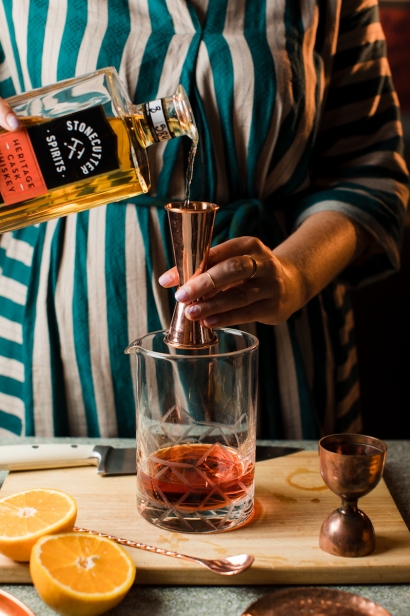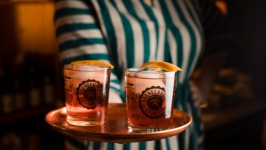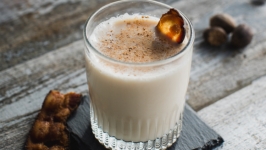Sas Stewart Cooks--And Drinks--at Home
Look around Sas Stewart’s apartment in Vergennes and you’ll notice coasters on pretty much every flat surface. That way her friends never have to worry about leaving a sweating glass on the furniture. Pro tip from a woman who loves to throw parties, and as co-founder of Stonecutter Spirits, Sas entertains. A lot.
“Besides, I don’t have a lot of fancy or fussy furniture,” she explains. “My style is a mix of modern and vintage, so nothing is trapped in time or straight out of a box. I just collect hand-me-downs or repurposed treasures from auctions or Craigslist. If a guest drops a bit of food or spills a drink, so what? It’s called a living room, after all!”
A giant writing desk covered with rows of bottles serves as the bar. On it sits a driftwood lamp from her family cottage in northern Michigan. The pine bookshelves adjacent are stocked with wines and special-release craft beers and ciders. Dog-eared cookbooks and well-thumbed cocktail manuals mingle with novels and gardening books.
Sas happily admits she’s food obsessed. “I host a cookbook club where I pick a book, select and scan a bunch of recipes and send them to my friends who like to cook and drink. People choose what they want to prepare, scaled for eight to 10 people, and we have a giant potluck flowing from one cookbook.”
The Detroit native worked in a series of food and beverage jobs through high school, college and beyond. Her obsession took her around the world with stops in Italy, Copenhagen, Hawaii, and New York City. However, it wasn’t till she moved to Vermont that she found her tribe.
Sas started Stonecutter Spirits in 2013 with Sivan Cotel, her business partner and co-founder. “Sivan had worked with whiskey, and I had experience in the food and strategy side.” Stonecutter started in Sas’s house in Addison County, where they experimented with gin recipes and bootstrapped it for a year. “We moved to Exchange Street in Middlebury in 2014 because we loved the craft booze movement in that town. It’s amazing— there are at least seven other beer, wine and cider makers within five miles of our distillery!”
A self-trained bartender, Sas was lucky enough to work in some of the best kitchens around the world. Sivan was second in command at Whistlepig for several years where he learned the art of creating aging ladders. “Together, we pooled our skills and just developed these products as we went. Our flagship product is a barrel-aged gin that we introduced to the public in 2015. I made the gin I really wanted to drink, and fortunately, other people have felt the same!” she laughs. In 2016, Stonecutter launched Heritage Cask Whiskey, a high-rye whiskey finished in cabernet barrels.
Stonecutter started in Vermont because of the climate. “We loved the physical setting, at the edge of the Green Mountains and near Lake Champlain. This topography produces dramatic weather patterns coming from the Adirondacks, which is fantastic for barrel aging. The fluctuations of temperature, barometric pressure and humidity draw the aging spirits through the casks. We also loved the collaborative food and drink culture here. I’ve lived in enough other places to know that this spirit of sharing and working together is unique to Vermont, where people will slog through every hardship to make the things they’re passionate about.”
Sas now lives in Vergennes, a town with active, engaged community members and a vibrant Downtown Alliance working to bring more energy and game to new ideas. A half-dozen members of the Stonecutter team have migrated to Vergennes as well.
By design, Stonecutter builds a packed event schedule that keeps Sas and company on the road and in their two tasting rooms, at the distillery in Middlebury and their new Highball Social in Burlington. “But if I do have a quiet weekend at home, I’ll text my best friend Martha Mack (also the director of beverage) who lives right upstairs. The evening snowballs from there. We’ll end up with at least six people and a couple of dogs, hanging out here in my apartment. I’ll mix up a pitcher of cocktails and pull out some Vermont cheeses and some frozen gougères I’ve already made and pop them in the oven. That makes entertaining super easy. If I’m going to focus on one thing, I put my attention on what we’re drinking and keep the rest simple. I’m a fan of offering lots of small bites rather than pulling off a dinner for eight guests. I sock away homemade nibbles in the freezer so I’ll always have something ready to pop in the oven when folks come over.”
Most gatherings start at the kitchen counter then shift to the living room. An old trunk with a metal top serves as the coffee table, big pillows double as landing pads, and comfy chairs and sofas invite lounging. A stack of new and old albums sits next to the record player.
“At the holidays, we do family brunches, so I created something a little boozy to complement that atmosphere. I make a pitcher of Thompson Family Punch, stemming from my mom’s side of the family in Detroit. I mix single-barrel gin and pomegranate juice in a big pitcher ahead of time, and when people arrive, I just add a bottle of chilled Champagne or prosecco. I welcome each family member with a glass when they walk in. Everyone’s a tad more enamored of one another after a glass or two of the punch...”
For Sas, a cocktail contains a balance of spirit, acid, sweetener and dilution. The melting ice opens a spirit the way air interacts with wine, teasing out flavors and nuances. Sas loves the equal parts pitcher cocktail. “I can mix up a batch in advance and just add ice when the guests arrive. A 1:1:1 ratio makes it easy to remember and effortless to assemble. You can focus on having conversations with your guests, which is why we all get together in the fi rst place!”
People often ask Sas how to stock a home bar. Naturally, she suggests a barrel-aged gin which is versatile and can be swapped out for whiskey. “It’s a brave new step in the world of gin and makes a nice Old-Fashioned,” she explains. Other Vermont products include Eden Specialty Cider’s Orleans, cider-based aperitifs with herbal notes. She also tops cocktails with Shacksbury rose cider, Citizen Cider’s Lake Hopper and Stowe Cider to add eff ervescence and dry sweetness.
Along with a variety of bitters and Campari or Aperol, she suggests vermouths and amaros. “I’ll pour a splash and add ice, or I’ll have sweet vermouth with tonic and an orange peel. These are easy and refreshing sippers with low alcohol.”
And how about books on booze and cocktail culture? “My three go-tos are Proof: The Science of Booze by Adam Rogers; Liquid Intelligence: The Art and Science of the Perfect Cocktail by Dave Arnold; and The Bartender’s Manual by Jim Meehan. We gave this as our staff holiday gift last year. A comprehensive book that delves into the mechanics of bartending and the history of spirits and classic drinks.”
Sas nestles deeper into a corner of her comfy couch and places her drink—on a coaster. “Vermont is maple, cows, skiing and covered bridges. But in 2018, it’s also people who own distilleries, grow flowers, make art and music and produce amazing food. Vermont attracts people who do creative things that generate community. Th at’s what drew me here. Once you fall in love with a place, you take on the responsibility to tackle the challenges and find solutions.”
Sas Stewart | @the_real_sas_stewart
Stonecutter Spirits | @stonecutterspirits
Sivan Cotel | @sivancotel
Downtown Alliance
Highball Social | @highballsocial
Eden Specialty Cider
Shacksbury Cider | @shacksbury
Citizen Cider | @citizencider
Stowe Cider | @stowecider
Proof: The Science of Booze
Liquid Intelligence: The Art and Science of the Perfect Cocktail
Dave Arnold | @cookingissues
The Bartender’s Manual
Jim Meehan | @mixography











